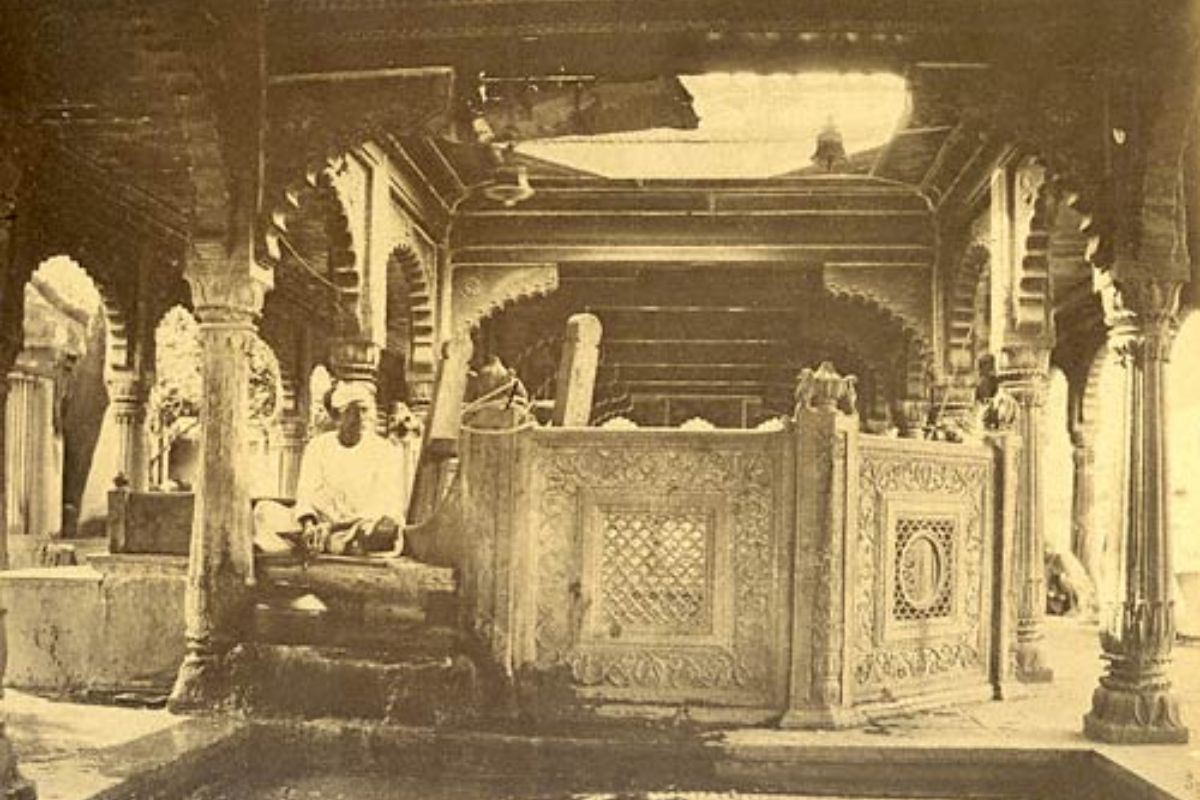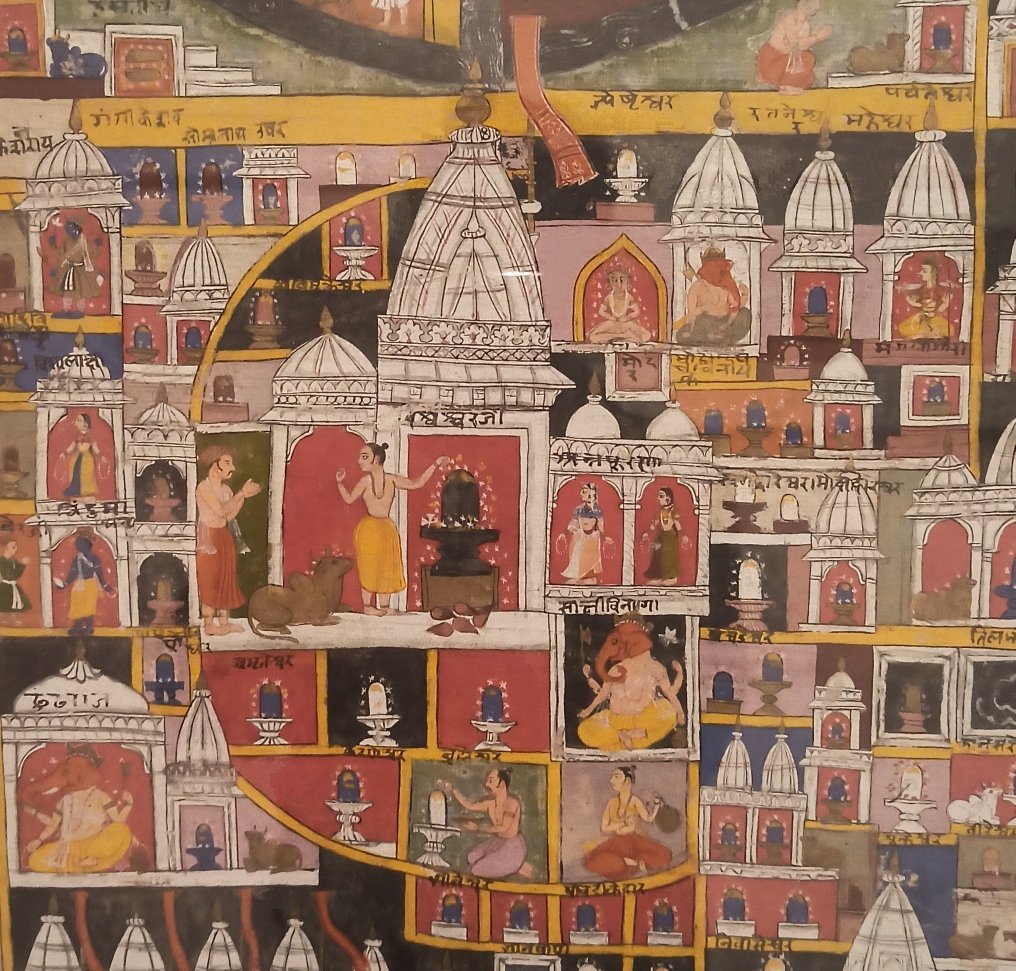
Gyanvapi is a sacred well, the well of knowledge which is situated on the north-eastern direction of Sri Kashi Vishwanatha Jyotirlinga. Even today one can have darshan of this holy well and drink water from it. It can be easily located next to big Nandi in Sri Vishwanath Temple.
This sacred well was created by Lord Ishana even before the descend of Mother Ganga onto this planet. Lord Shiva imparted the Vedic knowledge to Mother Parvati here. Hence it came to be known as Gyanvapi.
There are six vapis or wells in Kashi
- Jyeshtha Vapi in Kashipura (disappeared)
- Gyanvapi in Kashi Vishwanath Temple
- Karkotak Vapi popularly known as Nagkua
- Bhadravapi in Bhadrakupa locality
- Shankhachuda Vapi (disappeared)
- Siddha Vapi in Babu Bazaar (lost)
The Linga Purana, states:
देवस्य दक्षिणी भागे वापी तिष्ठति शोभना।
तस्यात वोदकं पीत्वा पुनर्जन्म ना विद्यते ||
One achieves freedom from the cycle of birth and death by drinking the water of Vapi which is in the southern part of the ancient Vishwaveshwara temple.
Skanda Purana mentions:
उपास्य संध्यां ज्ञानोदे यत्पापं काल लोपजं |
क्षणेन तद्पाकृत्य ज्ञानवान जायते नरः |
One must perform Sandhya Vandana with the water of jnana vapi. By doing so one shall receive knowledge and freedom from sin.
The origin and meaning of Gyanvapi
In samskruta vapi means well and jnana refers to knowledge. Long long ago even before the creation of rivers and rain, when there was no water on the Earth except sea or milk ocean, at that time Lord Ishana came to Kashi. There he saw a huge and endless column of light – the jyotirlinga. Devatas were worshipping that holy linga. Gandharvas, Kinnaras, Vidyadharas they were all glorifying this holy Shivalinga.
Looking at this glorious shiva-linga, Lord Ishana desired to perform its abhisheka. Since water was not available, he struck his trident into the ground giving a way to gushing water. In the southern direction of Jyanavapi a water kunda was thus created. He filled that water into thousands of kalashas and performed the abhisheka of that linga.
Lord Vishwanatha became pleased with the worship of Lord Ishana and granted him the boon that this tirtha will be known as Shivatirtha. Another meaning of shiva is jnana or vidvan. By the blessings of Lord Shiva, the vedic knowledge manifested in that water in the liquid form.
Therefore, this tirtha came to be known as Jnanoda. Today we all it as Gyanvapi.
योष्टमूर्तिर्महादेवः पुराणे परिपठ्यते ।।
तस्यैषांबुमयी मूर्तिर्ज्ञानदा ज्ञानवापिका।।
The water of Gyanavapi is the form of Lord Shiva.
The fall and rise of Gnanvapi Tirtha
In the year 2022 a great voice rose to reinstate the worship of Shringara Gauri which is located inside the Gyanvapi Mosque. Devotees also prayed to the court to handover the mosque back to Sanatana Dharmis or Hindus.
But why it must be handed back to us?
Gnanvapi is not a man-made place. It has been mentioned in the Vedic history of Indian Subcontinent. This history is recorded in the texts called as Puranas and Vedas. This vedic history is not man-written again. It has been given by the Supreme Lord Vishnu to Lord Brahma and handed down generation by generation through aural reception.
Even before the civilization word was born Kashi has been living. Lord Avimukteshwara – the swayambhu shiva-linga was worshiped in Kashi since time immemorial. This linga is also called as Adilinga or the first linga of Kashi. The glorious temple was a centre of development in India and more importantly preservation and promotion of Vedic Culture.
Not able to tolerate the greatness of this temple, the Muslim Invaders has been breaking this temple. The atrocities were repeated over a period to humiliate Hindus and to misuse their brotherhood and tolerance.
The Atrocities of Muhammad Ghori
Muhammad Ghori sent Qutbuddin Aibak to conquer Varanasi. In the attack of Qutbuddin Aibak, more than 1000 temples of Varanasi were destroyed, and the temple property is said to be loaded on 1400 camels and sent to Mohammad Ghori. After making Qutubuddin the so-called Sultan of India, Ghori returned to his country.
Qutbuddin Aibak appointed an officer in 1197 to rule Varanasi. Aibak’s rule in Varanasi tried its best to end Deity worship diligently. The result of this was that the damaged temples remained broken for years. But by 1296, the temples of Varanasi were rebuilt and again adorned Kashi.
Alauddin Khilji breaks the temple again
As though the wealth carried by 1400 camels was not enough, later Alauddin Khilji demolished the temples of Kashi and looted their wealth. In the 14th century, many mosques were built in Jaunpur and Varanasi during the reign of Tughlaq rulers. All these mosques were built on the remains of temples only.
In the 14th century, for the first time in Jaunpur, the Shaki Sultans got the Kashi Vishwanath temple demolished. During the time of Sikandar Lodi in the 15th century, all the temples of Varanasi were again demolished. And for years the temples remained in ruins.
Rise of Kashi Vishwanath in 16th Century
In the 16th century, during Akbar’s rule, his finance minister Todarmal, on the request of his guru Narayan Bhatt, built a temple of Vishweshwar in 1585, which is said to be the temple of Kashi Vishwanath.

Todarmal systematically established Vishwanath temple in Gyanvapi area. In the same period, the temple of Bindu Madhava was built by Raja Mansingh of Jaipur, but both the grand temples were again demolished during the reign of Aurangzeb. In fact, Aurangzeb built the Alamgiri mosque from the rubble of Bindu Madhava Temple.
In 1669, Aurangzeb had ordered the destruction of all the temples of Varanasi, after which four prominent mosques were built in Varanasi. Out of which three were built by demolishing the famous temples of that time. Gyanvapi mosque was built in the place of Vishweshwar Temple, Alamgiri in the place of Bindu Madhava Temple and Dharhara mosque in the place of Krittivaseshwara Temple.
When Aurganzeb attacked the temple, the pujari of Lord Vishwanath took the linga and made the ultimate sacrifice for protecting the linga from being broken by Aurangzeb. He took the linga and jumped inside the Gyanvapi well. Devotees believe that the original jyotirlinga is still present inside the well. However many believe that Lord Shiva went away in Ganga. Later Ahalyabai got a dream in which Lord Shiva directed her to go to Narmada and bring the linga to worship in Kashi.
There is no mention of the mosque anywhere in the 16th century maps of Kashi Vishwanath temple. In one such map prepared by the British officer James Princep between 1820-1830, Tarakeswar, Mankeshwar, Ganesh and Bhairav temples are visible on the four corners of the temple premises. The middle part is the garbha-griha where the Shivalinga is installed and Shiva temples are also visible on both sides of it.
The Mystery of Nandi
Today one can see Nandi in the temple complex which is facing the western wall of Gyanvapi mosque. Why? Because originally faces Shivalinga only.
It is claimed when Aurangzeb ordered to build a mosque after demolishing the temple, then the garbha-griha of the old temple itself was planned to be the main hall of the mosque. According to this plan, both the small temples and adjourned mandapas on the west were demolished and the main entrance of the garbha-griha, which was on the western side was selected. The main gates of the aishwarya mandapa and mukti mandapa were closed and this part of the temple became the western wall of the mosque.
The western wall of the temple was kept in such a broken condition because Aurangzeb wanted the Hindu society to feel inferior. When the temple was demolished, its debris was also allowed to lie there. The walls are the same even today. And the Nandi is still waiting for the darshan of his lord. To further this humiliation, Aurangzeb named it as Gyanvapi Mosque.
On August 15, 1947, Kedarnath Vyasji the legal heir of the Vyasapitha of Vishwanath Temple alone stopped namaazis to enter the Gyanvapi Mosque. He has been fighting this legal battle for many years now. Until Mulayam Singh barricaded the Gyanvapi mosque, Kedarnath Vyas ji would daily go through the steps in front of Nandi and offer the worships to Shivalinga.
Gyanvapi is the beginning of Panchkosi Parikrama
Gyanvapi is mentioned in the Panchkosi Parikrama of Kashi. Devotees perform sankalpa here, begin the parikrama and end it at the same place. Panchkosi Parikrama of Kashi has great importance in Sanatana Dharma. All the devatas reside within the Kashi mandala to serve Lord Keshava and Lord Vishwanath.
Current issue of Gyanvapi Mosque
On the plea of five ladies, court ordered a detailed survey of Gyanvapi mosque in the presence of various advocates and personalities. Extensive videography and photography were also done during this survey.
The cellars which have been locked for centuries, were initially not allowed to be opened but under the strict orders of court everything was documented. During the survey a Shivalinga was found right opposite to the Nandi outside the western wall.
This Shivalinga was concealed in the waters of Vazukhana – the place of washing hands and legs before reading the Namaaz. All these years they have been insulting our God, the Lord of Kashi by spitting and washing their dirty legs and hands in the same water. Court has ordered seal and protection of Shivalinga with immediate effect.
It is not long. Very soon Lord Vishwanatha will raise and give his darshana.
How to reach Gyanvapi?
Gyanvapi is situated within the temple complex of Lord Vishwanath. To know its glories and be blessed, you must join the Kashi Yatra of Tirtha Yatra.
Kashi is a well connected city by Railways, Airways and Roadways.
7










7 Comments On Gyanvapi
Ajay Kumar Pathak
Jai Veerbhadra Ji, Har Har Mahadev.
K.Chendra Sekhar
Godly feelings when I read this article
Mahantesh
Great.onde Matarum
AMBI
On reading in this article it is mentioned six viyapi or well was in kashi. Out of this two disappeared and one lost. That means all the three where occupied illegally and its predicted as disappeared and lost isit. If so who occupied it and where it is?
Sampat Shankar Pisal
It is very good inventory information of our old culture.
K.Chendra Sekhar
Godly feelings when I read this article
R.Venkatasubramanian.
Stunning and Divine feeling.Namasthe to all great souls in Humanity and their concerted efforts to bring back our Lord of the Universe.